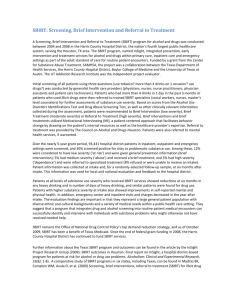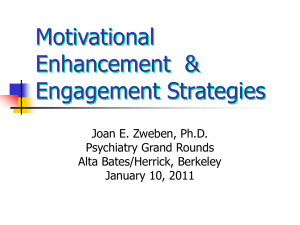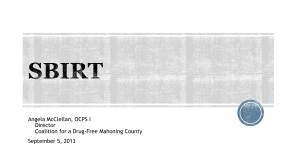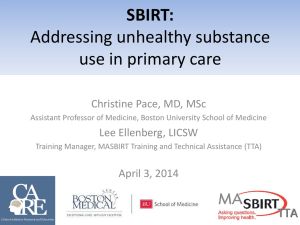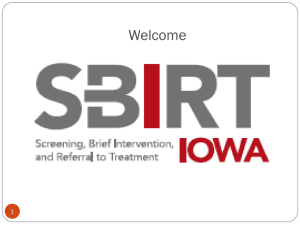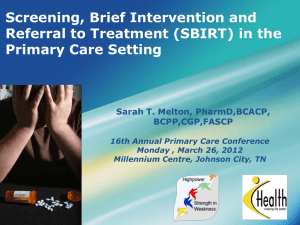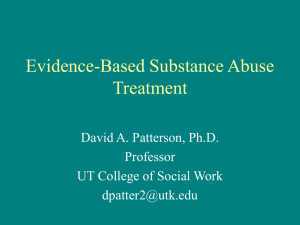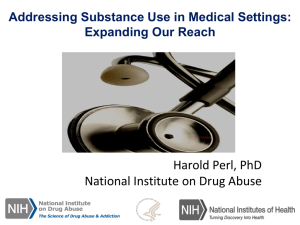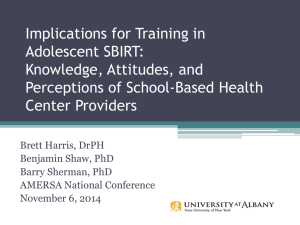SBIRT Protocol in Primary Care Settings
advertisement
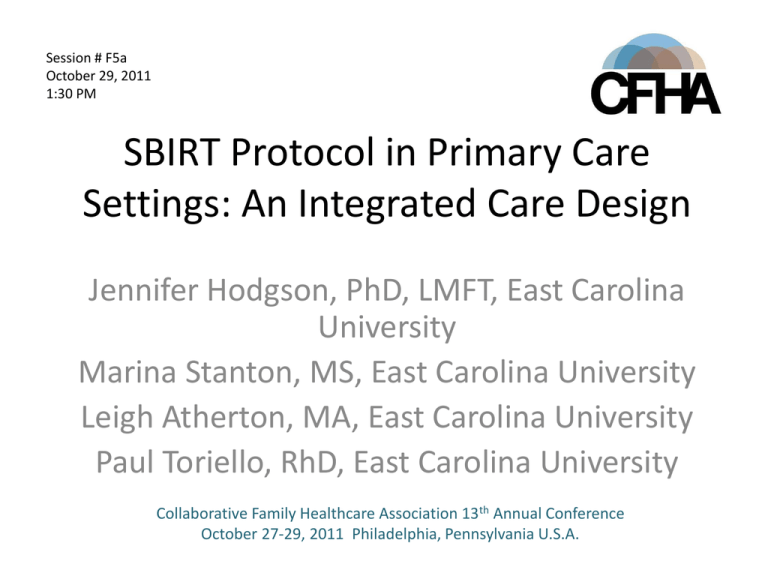
Session # F5a October 29, 2011 1:30 PM SBIRT Protocol in Primary Care Settings: An Integrated Care Design Jennifer Hodgson, PhD, LMFT, East Carolina University Marina Stanton, MS, East Carolina University Leigh Atherton, MA, East Carolina University Paul Toriello, RhD, East Carolina University Collaborative Family Healthcare Association 13th Annual Conference October 27-29, 2011 Philadelphia, Pennsylvania U.S.A. Faculty Disclosure We have not had any relevant financial relationships during the past 12 months. Need/Practice Gap & Supporting Resources What is the scientific basis for this talk? The SBIRT protocol is a SAMSHA endorsed method of improving the Screening, Brief Intervention, and Referral to Treatment processes needed in healthcare settings. SBIRT is evidence-based and practical as it draws from the Transtheoretical Model (Prochaska & DeClemente, 1983) and Motivational Interviewing (Miller & Rollnick, 2002) methods. Objectives Participants will…. Learn the infrastructure to the SBIRT protocol used in an FQHC and an academic integrated primary care setting. Understand the basics of how to use the Transtheoretical Model and Motivational Interviewing method with patients who are identified as at risk for or diagnosable with a substance abuse issue. Identify the successes and barriers found when implementing the SBIRT method by drawing from this team’s qualitative and quantitative research findings Discuss the next steps needed to sustain this type of protocol in FQHC and academic primary care settings. Expected Outcome What do you plan for this talk to change in the participant’s practice? Participants will learn some of the core infrastructure necessary to implementing the SBIRT protocol in a FQHC or academic medical center setting Participants will draw from the experience of the presenters to identify possible conduits and barriers to successfully implementing the SBIRT method TODAY’S TALK • Highlight the problem and proposed solution to addressing substance abuse issues in the primary care setting • Identify the settings and infrastructure needed to implement the SBIRT protocol • Discuss methods of implementation in each setting • Provide a sample of the outcome data from this project • Address next steps to enhancing and expanding this project Problem • Substance use disorders (SUD) are recognized as a multi-factorial health disorder, involving a complex interaction between individuals’ biological, psychological, and social factors. • Specifically, the interplay of SUDs and medical issues is well documented in the literature. • Researchers have estimated that there are 23.3 million people age 12 or older who meet criteria for a substance use disorder (SUD) – nearly 9% of the United States population.1 • Untreated, SUDs may account for a disproportionate amount of medical and mental health concerns.2 • The failure to recognize and appropriately address SUDs can lead to negative effects within the individual, family, and society. Solution • Early detection of SUDs, particularly within the primary care setting, can lead to successful management, and may prevent progression of both mental health and medical concerns. • Researchers have demonstrated that the SBIRT protocol in the primary care setting is an effective method for identifying and treating patients with SUDs. 3,4 • The stigma of treatment can frequently prevent those suffering from substance use disorders from seeking treatment within traditional substance abuse facilities. • SBIRT has been used effectively with a wide range of populations to address issues including: (a) smoking, (b) alcohol and/or illicit drug use and abuse, and (c) prescription use and abuse4. • Early detection of substance use and abuse issues can lead to successful management, and may prevent progression of both mental health and medical concerns. Settings • Setting #1 – Eastern North Carolina academic family clinic comprised of four separate treatment teams serving the needs of approximately 30,000 patients. • Setting #2 – Eastern North Carolina Community Health Care Center comprised of four separate primary care clinics serving the needs of approximately 30,000 patients. SBIRT Flow Chart ICARE Substance Abuse Encounter Forms Flowchart Patient checks in at front desk Front Desk Staff will give each patient ICARE Encounter form Patient will fill out assessment and return clipboard to front desk Nursing staff will look over completed assessment form Did patient answer “Yes” for question #2, #3, or #4 NO for EITHER question #2, #3, or #4 Please return completed form to folder at Nurses Station YES for EITHER question #2, #3, OR #4 YES. Nursing staff complete SECONDARY SCREENING (assess how much and how often) Fill out RECOMMENDATIONS TO PROVIDERS Nursing staff place completed form on the back of the door Provider will follow up with patient about their readiness to change Does patient need additional follow up or treatment for substance abuse? Not at this time. Yes. Treatment and referral should be based on patient’s needs Provider will fill out “Brief Intervention” completed, INITIAL FORM and return assessment to nurses station Provider will fill out information on back, INITIAL FORM and return assessment to nurses station Patient will give completed assessment to NURSING STAFF Nursing staff will fill out Medical Record Number SBIRT Screening Tools Pre-screening questions (ages 14 and older) 1. Do you drink alcohol? 2. In the past 12 months, have you used any drugs? 3. For prescription drugs, have you ever used more than prescribed, or used someone else’s prescription drugs? Secondary Screenings (based on positive pre-screening): –Adults Only (ages 18 and older) * * AUDIT (10-question alcohol use screen) DAST-10 (10-question drug use screen) –Adolescents Only (ages 14-17) * CRAFFT (6-question alcohol and drug use screen) SBIRT MI Card ICARE – Substance Abuse Screening/Intervention Short Reference Card • 5 – Key Questions about Substance Use/Abuse • 1. 2. 3. 4. 5. What do you like about using…? What concerns you about your use of…? How important is it, at this time, for you to change your use of…? How would you go about making those changes? What has worked for you in the past? How can we help you make these changes? Scaling Question • On a scale of 1 to 10, how motivated are you to change your substance use? Use follow-ups to elicit ‘change talk’: Why are you a ____ and not a [lower number]? What would it take for you to go from a ___ to a [higher number]? Rules of Advice/Suggestion giving • Advice/suggestions are given ONLY when: 1. 2. The patient solicits advice/suggestion; or The provider asks permission to offer advice/suggestion. Toriello et al., 2009 SBIRT MI Card (Back) Stages of Change Pre-contemplation Contemplation Realization Intervention Maintenance 1 2 3 4 5 • Pre-contemplation: Denial of problem Explore pros/cons of using Develop discrepancies between ‘wants & needs’ and ‘cons of current use’ Contemplation: Openness to potential problem Use of scaling question to explore current level of motivation Explore patient view of what change will mean for them Realization: Awareness of problem and ready to make change(s) Help develop ‘change plan’ Determine appropriate level of care Intervention: Doing it! Putting change plan into action. Schedule ‘check-in’ appointment Maintenance: 6 months or more of sustained ‘change’ Referral Information • East Carolina Behavioral Health—LME 1-877- 685-2415 http://www.ecbhlme.org/ The Beacon Center—LME 1-888-893-8640 http://www.thebeaconcenter.net/ SAMHSA—Substance Abuse & Mental Health Online Facility Locator: http://dasis3.samhsa.gov/Default.aspx Toriello et al., 2009 Outcomes Setting #1 Outcomes Setting #2 Provider Reported Barriers Time – “We only have so much time to spend with the patient, only fifteen minutes for their [physical health concerns] and don’t really have time to spend talking about [physical health and substance abuse]” Education – “All health care providers need more training [about how to address substance abuse]. Doctors are afraid of opening a door… and not knowing what to do with those issues.” Chronic Pain – “Doctor focus is on medical issues, while patients focus is on obtaining certain prescription drugs.” Patient Barriers – “[We] rarely have patients who are honest about their illegal drug use…” – “Some of the patients we can’t screen because we don’t know Spanish…we can’t even ask them the question…” Provider Reported Benefits Integrated Care – “People do come back…They may not be ready for help today, but [may in future] because of relationships with [staff].” – “Screening is like prevention. You do screening to prevent things upsetting or uh complications…I think we should be involved in the screening…” Education – “When we first started some of the patients were kind of irritated…but I think we’re getting better because I really don’t get that sense from the patients anymore.” – “A lot [of patients] don’t realize how alcohol especially, but any other drugs, [affect their medications and their health]. So that’s really an eye-opener for a lot of folks I think.” Readiness to Change – “There might be people who [screen positive] who wouldn’t have brought it up on their own. Because you brought it up, they do share and they do want help.” Team Perspectives Perceived Barrier 1. 2. 3. 4. 5. Time limited face-to-face contact with patients (average 15min) – difficulty addressing chief complaint AND SA concerns (if screened positive) Providers and clinical staff are not comfortable addressing SA issues within SBIRT context due to a lack of knowledge/expertise of SA Lack of internal and community resources for patients with chronic pain Stigma of substance abuse can cause many patients to feel uncomfortable talking abuse their substance use Language barrier between staff and Latino patient population Practice Change Innovations 1. 2. 3. Utilized existing staff resources to assist with follow-up services; Offered Care Management services Provided SA trainings ; in-service trainings and funding for external training opportunities; Created a referral list and coordinated with local community resources Coordinated with the local Pain Management referral source to coordinate services 4. Trained staff and providers on how to integrate conversation of SA concerns into medical service and use of motivational interviewing 5. Created screening forms in Spanish; Included “languages spoken” as an important aspect of the referral list Next Steps Barrier • Inpatient/residential level of care referral Next Steps • Resources for uninsured/under-insured 2a. Collaborate with local emergency departments (ED) to coordinate ‘warm hand-off’- complete referral on site and ‘hand-off’ to ED for labs and placement 2b. Collaborate with local mental health centers and lobby groups to increase state funding for uninsured/under-insured population 1. Collaborate with local Alcohol and Drug Abuse Treatment Centers (ADATC) and other inpatient facilities to streamline admissions issues Recommendations for Implementation 1) Get training in Motivational Interviewing and in the SBIRT Protocol (on line through SAMSHA website; www.SAMSHA.gov). 2) Get training in working in primary care settings (e.g., medical family therapy). 3) Contact local primary care practices to see if they have implemented SBIRT. If not, offer to do trainings and trial runs of it (pro bono if needed). 4) Collaborate with local substance abuse treatment centers and providers for referrals to treatment. Get contacts and a referral list together prior to initiating the SBIRT in any practice. 5) Respond to any barriers that surface within a week! Adjust protocol to fit needs of setting. 6) Get all screening tools into the electronic health record. 7) Use systems and relational skills to build and maintain patient, patient’s support system, and provider trust. References 1. Substance Abuse Mental Health Services Administration. (2007). Results from the 2006 national survey on drug use and health: National findings (Office of applied studies, SDUH Series H-30, DHHS Publication No. SMA 06-4194). MD: Rockville. 2. Samet, J. H., Friedmann, P., & Saitz, R. (2001). Benefits of linking primary medical care and substance abuse services: Patient, provider, and societal perspectives. Archives of Internal Medicine, 161, 85–91. 3. Babor, T.F., McRee, B.G., Kassebaum, P.A., Grimaldi, P.L., Ahmed, K., & Bray, J. (2007). Screening, Brief Intervention, and Referral to Treatment (SBIRT): Toward a public health approach to the management of substance abuse. Substance Abuse, 28(3), 7– 30. 4. Bien, T.H., Miller, W.R., & Tonigan, J.S. (1993). Brief interventions for alcohol problems: A review. Addiction, 88, 315–335. Contact Information • Jennifer Hodgson, PhD – hodgsonj@ecu.edu – 252-328-1349 • Marina Stanton, MS – Stantonm08@students. ecu.edu – 252-702-5044 • Leigh Atherton, MA – athertonw06@students. ecu.edu – 857-498-2512 • Paul Toriello, RhD – toriellop@ecu.edu – 252-744-6297 Session Evaluation Please complete and return the evaluation form to the classroom monitor before leaving this session. Thank you!

